|
||||||||||||||||||||||
![Home - Air Power Australia Website [Click for more ...]](APA/APA-Title-Main.png) |
||||||||||||||||||||||
![Sukhoi PAK-FA and Flanker Index Page [Click for more ...]](APA/flanker.png) |
![F-35 Joint Strike Fighter Index Page [Click for more ...]](APA/jsf.png) |
![Weapons Technology Index Page [Click for more ...]](APA/weps.png) |
![News and Media Related Material Index Page [Click for more ...]](APA/media.png) |
|||||||||||||||||||
![Surface to Air Missile Systems / Integrated Air Defence Systems Index Page [Click for more ...]](APA/sams-iads.png) |
![Ballistic Missiles and Missile Defence Page [Click for more ...]](APA/msls-bmd.png) |
![Air Power and National Military Strategy Index Page [Click for more ...]](APA/strategy.png) |
![Military Aviation Historical Topics Index Page [Click for more ...]](APA/history.png)
|
![Intelligence, Surveillance and Reconnaissance and Network Centric Warfare Index Page [Click for more ...]](APA/isr-ncw.png) |
![Information Warfare / Operations and Electronic Warfare Index Page [Click for more ...]](APA/iw.png) |
![Systems and Basic Technology Index Page [Click for more ...]](APA/technology.png) |
![Related Links Index Page [Click for more ...]](APA/links.png) |
|||||||||||||||
![Homepage of Australia's First Online Journal Covering Air Power Issues (ISSN 1832-2433) [Click for more ...]](APA/apa-analyses.png) |
||||||||||||||||||||||
| Last Updated: Mon Jan 27 11:18:09 UTC 2014 | ||||||||||||||||||||||
|
||||||||||||||||||||||
|
||||||||||||||||||||||
![Home - Air Power Australia Website [Click for more ...]](APA/APA-Title-Main.png) |
||||||||||||||||||||||
![Sukhoi PAK-FA and Flanker Index Page [Click for more ...]](APA/flanker.png) |
![F-35 Joint Strike Fighter Index Page [Click for more ...]](APA/jsf.png) |
![Weapons Technology Index Page [Click for more ...]](APA/weps.png) |
![News and Media Related Material Index Page [Click for more ...]](APA/media.png) |
|||||||||||||||||||
![Surface to Air Missile Systems / Integrated Air Defence Systems Index Page [Click for more ...]](APA/sams-iads.png) |
![Ballistic Missiles and Missile Defence Page [Click for more ...]](APA/msls-bmd.png) |
![Air Power and National Military Strategy Index Page [Click for more ...]](APA/strategy.png) |
![Military Aviation Historical Topics Index Page [Click for more ...]](APA/history.png)
|
![Intelligence, Surveillance and Reconnaissance and Network Centric Warfare Index Page [Click for more ...]](APA/isr-ncw.png) |
![Information Warfare / Operations and Electronic Warfare Index Page [Click for more ...]](APA/iw.png) |
![Systems and Basic Technology Index Page [Click for more ...]](APA/technology.png) |
![Related Links Index Page [Click for more ...]](APA/links.png) |
|||||||||||||||
![Homepage of Australia's First Online Journal Covering Air Power Issues (ISSN 1832-2433) [Click for more ...]](APA/apa-analyses.png) |
||||||||||||||||||||||
| Last Updated: Mon Jan 27 11:18:09 UTC 2014 | ||||||||||||||||||||||
|
||||||||||||||||||||||
| Phazotron
Zhuk AE/ASE Assessing Russia's First Fighter AESA Technical Report APA-TR-2008-0403 |
||||||||||||||||||||||||||||||||||||||||||||||||||||||||||||||||||||||||||||||||||||
|
||||||||||||||||||||||||||||||||||||||||||||||||||||||||||||||||||||||||||||||||||||
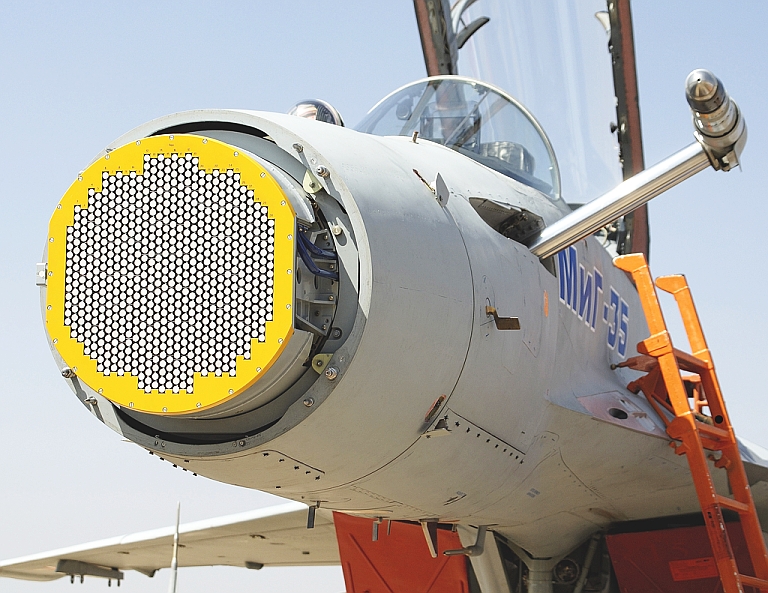 The MiG-35 Zhuk AE AESA designed by Phazotron is the first Russian AESA design and is expected to spawn upgrade packages for Flanker variants, as Phazotron have been trying for over ten years to break NIIP's defacto monopoly on volume production Flanker radars (MiGAvia.ru).
 |
||||||||||||||||||||||||||||||||||||||||||||||||||||||||||||||||||||||||||||||||||||
|
|
||||||||||||||||||||||||||||||||||||||||||||||||||||||||||||||||||||||||||||||||||||
Background and Zhuk Development HistoryRussia's radar industry has
survived the post Cold War trauma of collapsing budgets and has since
then strongly reoriented towards export markets. Of the three most
prominent radar houses, Tikhomirov NIIP, Phazotron NIIR and Leninetz,
Tikhomirov NIIP has enjoyed the largest export sales volumes and
earnings mostly by virtue of its entrenched position as supplier of
Flanker radars. Phazotron on the other hand has carved out a niche as
the technological innovators in the Russian industry.
Phazotron has a long history as one of the leading Soviet era radar design bureaus, and were the primary designers of the N019 Topaz / Slot Back series of pulse Doppler radars for the MiG-29 Fulcrum fighter. The Zhuk family of radars, which has largely occupied Phazotron's designers since the end of the Cold War, are an evolutionary offshoot of the N019 family. The first of the Zhuk (Beetle) radars was developed for the stillborn mid 1980s MiG-29M/MiG-33 Fulcrum upgrade and production effort. Designated the N010 Zhuk, this was a relatively modern pulse Doppler design modelled on the US APG-65 and APG-68 radars, using a slotted planar array antenna with a 0.68 metre diameter aperture, with an average power rating of 1 kW and peak rating of 5 kW. With the end of the Cold War and Phazotron's emergence as an independent entity in an open market, the effort invested into the Zhuk was exploited to develop a family of radars designed for the MiG-29, Su-27/30 and older Soviet era fighters as upgrades. The Zhuk-27 was a variant of the baseline N010 but fitted with a much larger 0.98 metre diameter slotted planar array antenna, and possibly an uprated TWT, intended for the Su-27SK Flanker B. Its contemporary was the Zhuk-8P developed for the PLA-AF J-8-II Finback, with a smaller antenna and thus lower range performance. Importantly this period also saw the development of the Zhuk-F, a passive ESA (PESA) or phased array with a 0.98 m diameter aperture. The Zhuk-F evolved further into the Sokol, which is the basis of the current Zhuk-MSF/MSFE PESA variants for the Flanker. The PESA variants of the Zhuk compare most closely to variants of the N011M BARS, but use a fixed PESA aperture rather than NIIP's gimballed design. The nearest Western technological equivalent is the French RBE2 PESA radar in the Rafale. 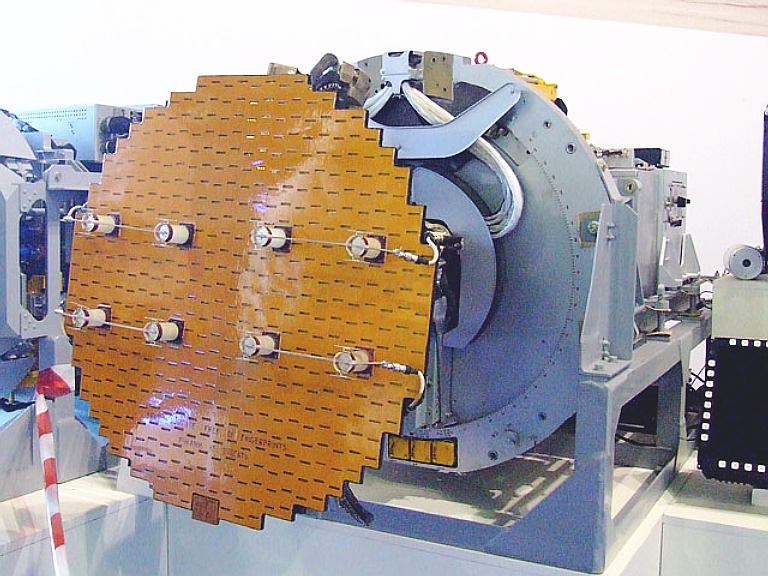 The Zhuk ME is a conventional derivative of the Zhuk M family, available in the 0.7 metre aperture configuration for the MiG-29, or the larger 0.96 metre aperture configuration for the Su-27/30 series. The Zhuk MSE was flight tested and certified on the Su-30MK3 variant developed for the PLA-AF but to date not ordered. The baseline mechanically steered Zhuk further evolved, with the N010M Zhuk-M and Zhuk-ME variants for the MiG-29 Fulcrum, and Zhuk-MS and Zhuk-MSE intended for the Su-27/30 Flankers. These incorporated an array of L-band IFF dipoles, a slotted planar array, and much improved processor hardware, to support strike modes including Synthetic Aperture Radar imaging [1].  The Zhuk MSF/MSFE (above) is a passive ESA design intended to compete against the NIIP N011M BARS. It uses a Phazotron unique radial distribution arrangement in the backplane waveguide feed, and proprietary radiating element placement. The Zhuk MSFE has a .98 meter diameter aperture with 1662 radiating elements, and was developed for the Su-30MK3 Flanker G avionic suite intended for the PLA-AF. The Zhuk-MSFE is being flown in an Su-33UB demonstrator, the depicted example (below) with thrust vectoring Al-31FU engines (MAKS 2005/2007). 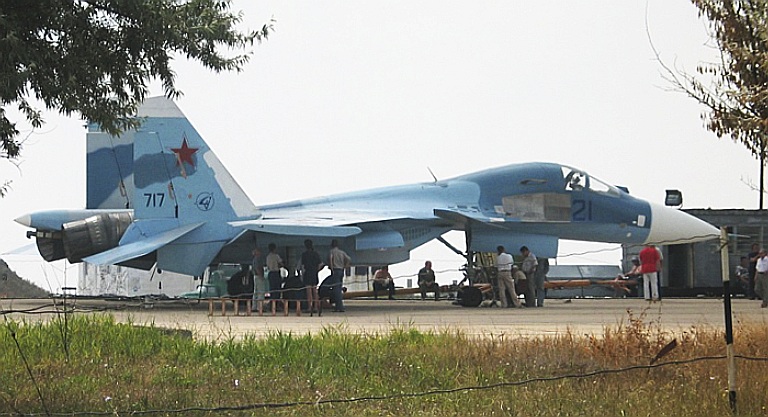 The most advanced of the Phazotron Flanker radars is the Zhuk-MSFE PESA variant, currently being flight tested on the Su-27KUB/Su-33UB side-by-side cockpit navalised Flanker variant, likely to be acquired by the PLA-N as part of their intended carrier airwing for the Varyag CVA. This radar is usually credited with a 2 KW average power rating and 8 kW peak power rating, putting it in the performance class of the NIIP N011 MSA radar on the Su-27K/Su-35 Flanker E. The PESA design has 1662 radiating elements.
The Zhuk-AE AESA [Click for more ...] is an offspring of the Zhuk-MF/MFE variant, a 0.7 m diameter aperture PESA derivative of the N010M Zhuk-M and Zhuk-ME variants, and was developed for the MiG-35 Fulcrum being bid for India's MRCA requirement to replace initially 128 of around 400 legacy Russian fighters. The potentially large size of the Indian order has seen Western and Russian bidders disclose remarkably large amounts of data on their products, and Phazotron produced a special issue of their house journal Phazotron, which contains some very good technical papers by Phazotron engineers detailing the internals of the Zhuk-AE and its underlying design philosophy. This is the single biggest technical disclosure on any AESA design, globally, to date. This APA analysis is largely based upon this document, but also exploits other open source materials. The strategic importance of the Zhuk AE cannot be understated. Russian industry has crossed the key hurdles of designing and integrating viable GaAs MMICs and performing the overall integration and design of an AESA. From this point we will see increasingly convergence with Western technology for AESAs, as new technologies like Gallium Nitride HEMT transistors are incorporated, and US style tiled packaging technology emulated. The rate of advancement will be mostly limited by the scale of investment into development. This analysis looks closely at the technology of the Zhuk AE and its design philosophy, in more technical depth than previous APA technical reports, and explores the implications of Phazotron's stated intent to scale the design up for the Flanker. |
||||||||||||||||||||||||||||||||||||||||||||||||||||||||||||||||||||||||||||||||||||
 Zhuk AE demonstrator on display at
MAKS2007. It is conspicuous that the radar operates at the lower end of
the X-band, following past Russian practice.
Zhuk AE Design Philosophy - A Radar Engineering PerspectivePhazotron's engineers have
provided some excellent insights into the design philosophy and
achievable performance, and performance growth, in the Zhuk AE design [click for more ...]. Less fortunately, the
original works were not well translated into English, seeing much
technical language translated improperly, making the original work less
than comprehensible to readers without exposure to radar engineering.
The starting point for the Zhuk
AE design was the existing Zhuk MF, as Phazotron's engineers correctly
assessed that the cost and risk of an entirely new design would be too
great. In this respect they followed the model used by Raytheon in the
APG-79 and Northrop-Grumman in the APG-80, rather than the 'all new'
approach seen with the Northrop Grumman APG-77. The aim was to
re-engineer the PESA design for a new liquid cooled AESA, retaining as
much of the PESA design as was feasible. Key design aims were to
provide improved reliability, agile beamsteering, reduced noise figure
to improve range, and much greater bandwidth to provide frequency
agility, facilitating aperture use in jamming and high rate
datalinking. Frequency agility was clearly sought with Low Probability
of Intercept (LPI) modes in mind, even if not stated.
Phazotron contracted NPF Mikran at Tomsk, a semiconductor manufacturer, with support from the Tomsk Electronics University, to develop the Gallium Arsenide MMIC (Monolithic Microwave Integrated Circuits) technology for the radar's critical TR Modules. The new radar would use a new antenna and Analogue/Digital Converter (ADC) design, a new exciter/driver stage, but retain the existing receiver chain, processors, and coherent oscillator. Intended improvements for a production design include better processing and a broadband programmable master oscillator module. The latter is to provide many of the advanced capabilities seen in the latest Western AESAs. Phazotron summarise the key design components as:
The design aim was to build an X-band array with a maximum beamsteering angle of 70°, without any unwanted sidelobes arising. This is the basic problem in all AESA designs, insofar as grating lobes require element spacing of less than one half of a wavelength, while the resulting packing density presents heat transfer problems. The power rating and PAE (Power Added Efficiency) of the driver transistor was considered another issue, with initial estimation at 6 to 8 Watts CW (12 to 16 Watts peak at 50% duty cycle). The small size of the aircraft and its limited power and cooling capacity were seen to be serious constraints. The drive transistors are operated in A-class to provide best possible linearity, with a performance penalty in a design with an overall PAE of 22% to 25%. C-class operation was rejected due to its adverse impact on signal purity. Phazotron have stated, not surprisingly, that the biggest difficulties were encountered in engineering the TR modules. The approach taken after evaluating dozens of alternatives was to integrate four TR channels into a single "quad" module, as this was found to be the most practical tradeoff. An interesting observation is that this is a scheme identical to that used for first generation AESAs by US designers in the late 1980s, followed by the TR "stick module" scheme used in early US production AESAs. Thermal management proved to be the single most difficult problem, and Phazotron claim to have finally produced a design with very high heat transfer efficiency. The intent of the production Zhuk AE configuration is to provide a package which allows direct upgrades of legacy Fulcrum radars in existing aircraft, as well as provide radars for new production aircraft. Phazotron's objectives for the production phase of the Zhuk AE lifecycle include full automation of AESA component testing, signal simulators to permit more extensive testing of operating modes and performance, better firmware and software for the radar's processing components, more effective algorithms for signal processing and beam control, and a statistical database for managing reliability over the lifecycle of the equipment. Extensive design tradeoff studies were performed, covering power aperture and range performance vs thermal load performance for average TR module power ratings from 1 Watt to 15 Watts. A major issue was beamsteering to 70° as issues arose with sidelobes and projected aperture area beyond 60° of beamsteering angle. An idea explored and rejected was the use of simultaneous multiple mainlobes, as this presented a range of unwanted difficulties. Phazotron appear to be exploring digital beamforming techniques in what Chief Designer Dolgachev describes as a two stage processing scheme, with initial beamforming performed in the AESA, and additional beamforming in the digital receiver, downstream of the ADC stage. Adaptive nulling of mainlobe jammers is also raised as a benefit of the AESA design. Dolgachev also observed that a key factor in the design process was maintaining a focus on key performance parameters, and exploiting computational simulations extensively throughout the design process. The starting point for the AESA design was the development of a complete computational simulation for the design, the aim of which was to explore various design tradeoffs to find those which worked best. Single channel TR modules were rejected in favour a more thermally efficient 4 channel quad module design. The proprietary diamond lattice placement of radiating elements used in earlier PESAs was rejected as it presented difficulties in splitting the array cleanly into the multiple phase centres required for monopulse angle tracking, nevertheless the stagger in the elements still provides a robust diamond lattice pattern. The resulting module configuration is designed to carry RF signals along the shortest geometrical path between the array face and the feed, with coolant flow transverse (normal) to the antenna boresight. The result of these tradeoff studies resulted in the final placement of the radiating elements in vertical columns, each comprising an integer multiple of four elements to accommodate the TR module structure. Performance achieved for the final element placement was a first sidelobe at -30 dB, an average of higher order sidelobes at -50 dB, mainlobe width degradation of 4 dB at maximum beamsteering angle, and no grating lobes within the sought beamsteering angular range. Computational simulations were performed to determine the appropriate quantisation increments for antenna TR channel phase and gain control. Five bits were found to be adequate for amplitude, and six bits for phase control. Each TR channel in the array is individually addressed on the control bus. The backplane feed uses an undisclosed radial waveguide design, rather than the segmented linear branched feeds seen in first generation Western AESAs and ESAs. A network of coaxial waveguide switches between the feed network and TR modules is used to manage phase centres and perform monopulse summing and differencing for angle track modes. Power supply distribution to the TR modules presented similar problems with module 'pulling' during current drain transients, and was accommodated by the pragmatic expedient of attaching a large charge store capacitor on the main power bus near each of the TR modules. Cooling was arranged by mounting each TR module on an integral frame cold plate, the latter being actively cooled by liquid flow. Heat is transferred from each MMIC or transistor into the base of the module, and then into the cold plate for removal. Phazotron have not disclosed the thickness of the cold plates or TR modules, but clearly the horizontal element pitch is the hard constraint here. Each TR module includes an embedded thermal sensor which forces a module shutdown if overheating occurs, and restart cannot occur until the module cools down. All modules are thermally compensated in amplitude and phase to ensure that the performance characteristics remain aligned regardless of temperature and operating frequency. Dolgachev describes the current TR module parameters as such:
An exciter preamplifier stage was developed to boost the output from the master oscillator module to compensate insertion loss from injection into the antenna feed backplane. The liquid cooled amplifier module has four ganged amplifier chains with a peak power output said to be 20 Watts. An automated arrangement was set up to test amplitude/phase performance of the TR modules, to permit calibration and compensation of errors to meet the required 3° error bound. Further automated equipment needed to be developed to measure and calibrate the fully assembled array, since the average power output of around 3 kW presented a hazard to personnel. A test rig using a power sensor aligned with the antenna boresight was used, with each module driven separately (with all others shut down) to measure the installed phase and amplitude performance. Measurements were then processed in software to determine overall antenna performance. Phazotron believe that the existing Zhuk AE design is performing below its potential, since much of the processing it uses was taken unchanged from earlier mechanically steered arrays and is thus not optimised to exploit the AESA. A separate paper by Semyonov et al discusses in some detail the design of GaAs MMICs used in the gain control, driver and phase shifter blocks of the TR channel. These were packaged together in single 8 x 22.5 x 2.5 mm sized hybrid with a heat transfer optimised metal case. The 5-bit digitally controlled attenuator is a GaAs MMIC die which uses 50 Ohm/sq resistive film for resistor components. The active components are Schottky transistors. High order bit stages are implemented in two 8 dB stages, for a total of 16 dB of controlled loss. The low order bit control stages are implemented as 1 dB stages. The total insertion loss of the controlled attenuator is 8 - 10 dB, with an RMS error of 0.5 dB between 4 and 11 GHz, and total attenuator bandwidth of 4 to 14 GHz. The 6-bit phase shifter function was split between two GaAs MMIC dies. Phazotron have stated that the shifters were intentionally built using a folded directional coupler design rather than switched filters. The four higher order bits, covering 180.0°, 90.0°, 45.0° and 22.5° shifts are implemented on one die, the two low order bits for 11.25° and 5.625° shifts on a second smaller die. This approach was chosen to bypass problems with device yield in production. It is intended that the 4-bit shifter be further improved to decrease the sensitivity of the 180.0° stage to production variations, and to reduce the per stage insertion loss from 2.5 dB to 1.5 dB. The design has been proven to perform between 8 and 11 GHz with an RMS phase error of around 6°, i.e. one bit. To compensate for the insertion loss of the attenuator and phase shifter stages, an additional buffer amplified was included in the hybrid design. This GaAs MMIC design provide 7 to 9 dB of gain between 8 and 11 GHz. According to Phazotron, the performance of the hybrids proved initially below expectations, with excessive phase and attenuation errors, due to problems with the alignment of the wires used to connect the dies to the package pins, assessed to be an inherent problem of the packaging used. The intent is to move to LTCC (Low Temperature Cofired Ceramic) and MCM-D (Multi Chip Module - Deposited) technology to get high production yields. In prototype modules, most of the gain and phase errors were actively compensated by control inputs to the array. Phazotron envisage the Zhuk AE as a new production radar, as well as an upgrade package for legacy MiG-29 Fulcrum fleets. A scaled up variant for the Flanker is also envisaged.
The first AESA to field operationally was the AN/APG-63(V)2 on the F-15C. It is a major upgrade of the original AN/APG-63(V)1 radar using a 1500 element AESA. Taking a critical technical perspective view of the Zhuk AE, it is a remarkable exercise in producing a viable design using a technology base which shows underinvestment in key areas such as component packaging and MMIC fabrication. Technologically the Zhuk AE compares best to first generation US AESAs like the 1990s APG-63(V)2 design deployed in limited numbers on the F-15C fleet. The technology especially for module packaging is similar to late 1980s US developmental designs.The first observation any Western radar engineer will make is that the Zhuk ME with 652 TR channels has between 50% and 70% of the TR channels of a comparably sized US radar, which is typically in the 900 to 1200 single TR channel module count class. This is a byproduct of the packaging technology available to Russian industry, which is a generation behind the US and EU in this area. That is no accident insofar as the US invested vast sums into the development of high density packaging techniques suitable for the thermally challenging environment of the AESA antenna.  The US industry abandoned multi-channel TR module technology during the early 1990s due to poor production yields and reproducability, introducing tiled single channel TR modules technology instead. In these modules, functions are divided by layer, and heat carried out of the module via the surrounding metal component. While Russian industry has yet to cross the hurdle of their first AESA using tiled modules, they have the US model to emulate and will thus take less time to introduce this technology than US industry did. In the words of one senior US engineer, "we had to learn the hard way" (Stimson).  Two early US designed quad (4 channel) transmit receive modules, which are similar in design to the Phazotron modules used in the Zhuk AE (Image "MIMIC Phase I Briefing", March 25, 1992, approved for public release, Director ARPA DMO, April 6, 1995). The low element count will be reflected in sidelobe performance, to the extent that a relatively sparse array like the Zhuk AE design is inherently much more sensitive to phase and amplitude errors in the array TR channels, compared to more dense arrays. This is difficult to assess accurately in the absence of performance data for the phase and amplitude error correcting mechanisms embedded in the array. If they perform well, this may not prove to be an issue, if not, sidelobe performance cited at -30 dB may be difficult to maintain. Phazotron have not disclosed the taper (illumination) function employed nor even alluded to such. The choice of taper function will influence aperture efficiency, sidelobe behaviour and phase front behaviour in the mainlobe. As it is one of the parameters applied dynamically to the TR channel gain settings, Phazotron's taper functions are likely to evolve in this area over time. Beamsteering agility in terms of duration to switch modules has also not been disclosed, but given other Russian ESA designs a figure of the order of 0.4 milliseconds can be expected. The Russian TR modules deliver around 5 Watts average power per channel, with no disclosed peak power per module. The peak power for the Zhuk AE has however been disclosed at around 6 kW which puts the per TR channel peak power at around 10 Watts, accounting for some taper function induced reduction in overall power output. What Phazotron have not disclosed is the headroom in cooling capacity provided by the TR module packaging and cold plate design, which will put the upper bound on TR channel output stage peak power ratings, but they do allude to growth potential. Given the penchant of Russian designers to build as much headroom as possible into designs, this may not be a critical constraint to long term growth of the design using newer Gallium Nitride transistors. The bandwidth of the AESA has not been disclosed, the critical bottleneck in any such design is usually in the phase shifter blocks, as GaAs MMIC amplifiers are inherently wideband. Therefore an estimate for the TR module of 2-3 GHz centred on 9.5 GHz will not be unreasonable, with potential for further growth with refinement of the gain/phase block MMIC designs and packaging. This is however not consistent with the array design. The upper frequency bound of the AESA will be determined by element spacing and grating lobe formation, for the existing design this appears to be at 8.5 GHz assuming for a diamond lattice a 17.5 mm spacing in the horizontal plane. This suggests a usable bandwidth of around 1 GHz or less centred on less than 8.5 GHz, accuracy of measurement permitting. The details of the radial feed have not been disclosed and this may further constrain usable bandwidth. The literature cites "16 centre frequencies" which if separated by 100 MHz bandwidth would suggest 1.6 GHz, feed permitting. This would put the centre of the band coverage at about 7.7 GHz which would be consistent with past practice. Structural mode radar cross section should be reasonable for the tilted production configuration, but less so for the demonstrator with is aligned in the vertical. The large edge area surrounding the 0.6 metre aperture area in the 0.7 metre antenna structure provides some opportunity for lossy edge treatment, but none is visible on the demonstrator. A frequency selective screen panel might also be employed, but was also not visible on the demonstrator. An aggregate noise figure for the receiver of 3 to 3.5 dB is not unreasonable. This would yield a highly competitive receive path sensitivity compared to current Western AESAs. Performance parameters for the ADC and master oscillator have not been disclosed. Reliability of the Zhuk AE might not appear to be as good as Western AESAs due to the packaging technology used, although Phazotron marketing material puts the figure at a respectable 900 hr MTBF which compares closely to the 917 hr MTBF of the more complex US APG-79 AESA. This may reflect yet again the Russian propensity to overdesign components, which in a thermally challenged design amounts to using devices well below their maximum power ratings. In terms of gross power aperture performance the Zhuk AE looks good in peak power, competing well against all Flanker radars including the N011M BARS, but suffering like all F-16 and F/A-18 sized radars from a small aperture size, which compromises overall detection range performance. In terms of growth in the design, as long as the existing packaging and thus element spacing are used, increasing antenna bandwidth is likely to require centre operating frequencies well below 8 GHz. Clearly if the module cold plate design and cooling system can cope, there are no issues with boosting TR channel peak power output by using higher power rated Gallium Nitride commercial transistors sourced in the West - this might well be worth doing even if it imposes duty cycle restrictions on maximum range search modes. Other important determinants of performance such as oscillator parameters and ADC dynamic range and noisiness have been conveniently omitted from the public disclosure. What is clear is that a MiG-29/33/35 Fulcrum fitted with a Zhuk AE will robustly outperform baseline F-16 and F/A-18 configurations, other than the F/A-18E/F/BII. It will not be competitive against any F-15 radar. |
||||||||||||||||||||||||||||||||||||||||||||||||||||||||||||||||||||||||||||||||||||
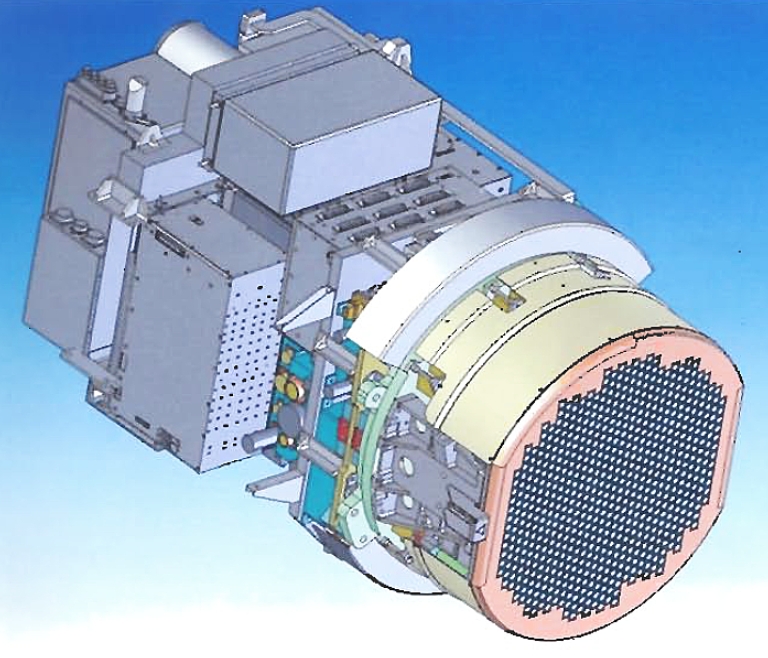 Concept
illustration of the intended Zhuk AE design.
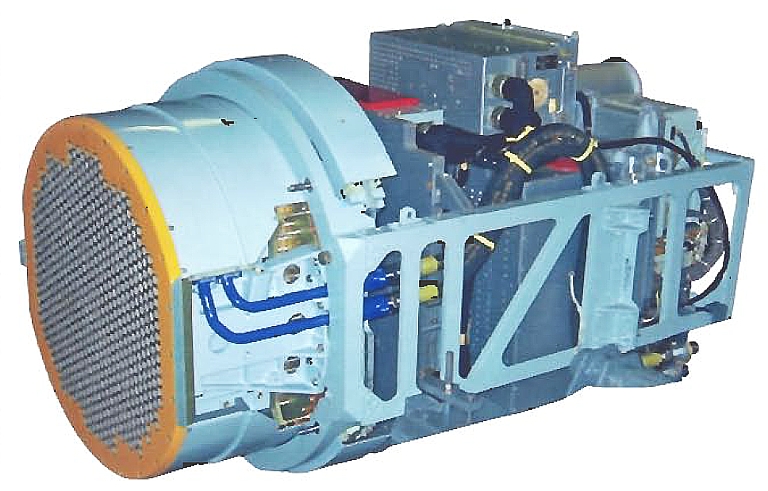 Digital
3D CGI rendering of the
Zhuk AE design.
 General arrangement of the Zhuk AE
AESA
radar. While prototypes have not used canted antenna placement,
Phazotron claim to be planning a canted antenna arrangement as
this improves coverage during aircraft turns and reduces
structural mode RCS from the antenna face.
|
||||||||||||||||||||||||||||||||||||||||||||||||||||||||||||||||||||||||||||||||||||
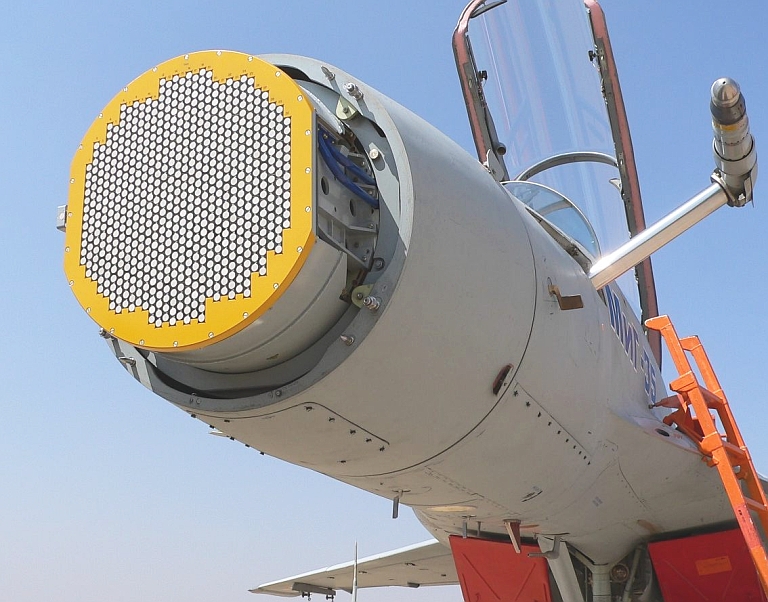 Zhuk AE installed in the MiG-35
demonstrator. There are 652 radiating elements employed, in a diamond
lattice pattern, each vertical row comprising groups of four quad TR
modules, with a total of 163 used. This is a conceptually
similar arrangement to the earliest US AESA arrangements, using a row
length adjusted with displacement from the antenna centreline.
|
||||||||||||||||||||||||||||||||||||||||||||||||||||||||||||||||||||||||||||||||||||
Zhuk AE AESA Specifications and Cardinal Design Parameters
|
||||||||||||||||||||||||||||||||||||||||||||||||||||||||||||||||||||||||||||||||||||
 Zhuk AE quad (4 channel) TR Module hybrid
with
the cover removed. Note the use of a US Altera EPLD as the control
logic element in this design. The control interface is to the left, the
RF interface to the emitter elements in the antenna face is to the
right. The module is a cold plate design built to transfer heat from
the base of the module into a liquid cooled cold plate with a flow
transverse to the antenna boresight. For comparison, see above US
module design.
 GaAs 4-bit phase shifter MMIC die. 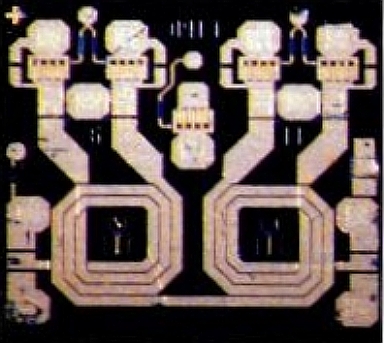 GaAs 2-bit phase shifter MMIC die.  GaAs Gain Controller MMIC die. 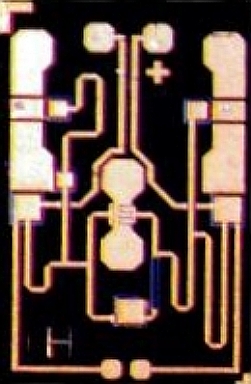 GaAs buffer amplifier MMIC die. 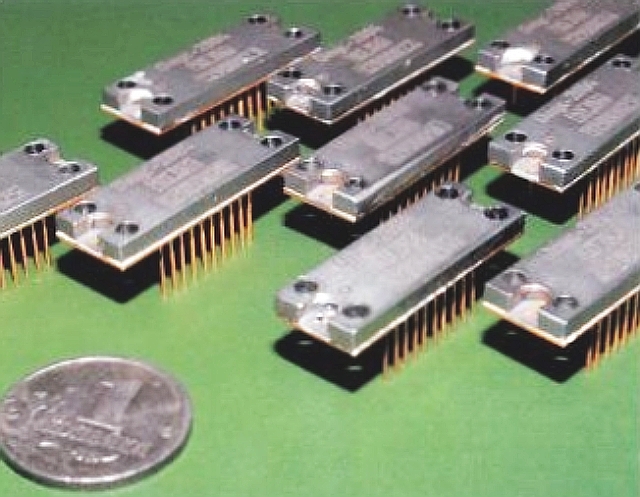 Packaged Gain and Phase Control GaAs hybrids for use in TR module construction. |
||||||||||||||||||||||||||||||||||||||||||||||||||||||||||||||||||||||||||||||||||||
 Zhuk
AE mockup on display at MAKS 2007.
|
||||||||||||||||||||||||||||||||||||||||||||||||||||||||||||||||||||||||||||||||||||
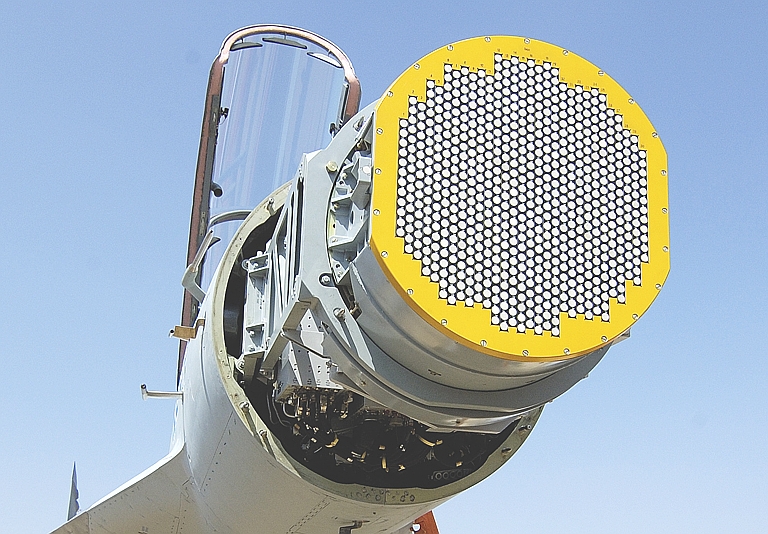 Zhuk
AE exposed for maintenance on LRUs.
 |
||||||||||||||||||||||||||||||||||||||||||||||||||||||||||||||||||||||||||||||||||||
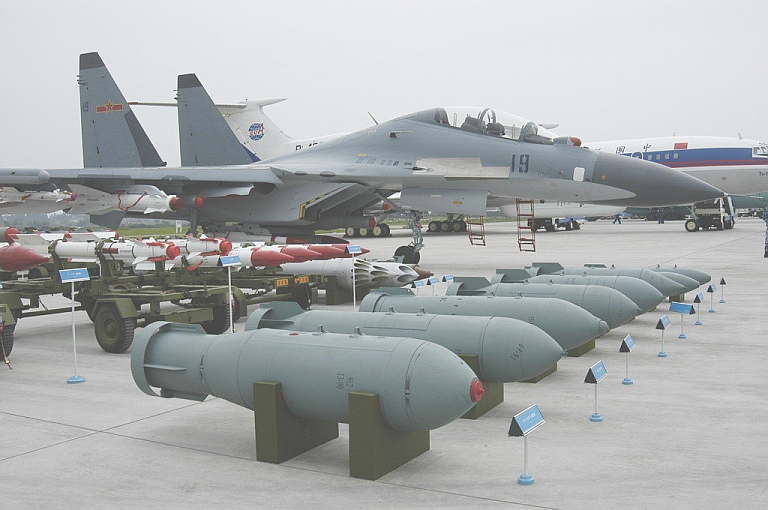 The
big
long term prize for Russia's radar industry is the block upgrade market
for earlier Flanker variant fleets. This market is dominated by early
Su-27SK, J-11B, Su-30MKK, and Su-30MK2 variants, all of which are
equipped with low peak power rated legacy N001/N001V series MSA radars,
built using 1980s MSA technology. This market comprises up to 500
aircraft upgrades, especially the PLA-AF and PLA-N fleets
(Xinhua).
Zhuk ASE AESA - Scaling the Zhuk AE for the FlankerOne of the stated intentions of
Phazotron is to scale up the Zhuk AE for the Flanker, in the manner of
the Zhuk-27 and Zhuk-MSFE variants, using a 0.98 metre diameter
aperture.
If we assume that such a scaled up design uses exactly the same quad module technology as the Zhuk AE does, and an enlarged cooling plate and mounting frame, then the achievable performance will scale with the aperture size. For the 0.98 m antenna outside diameter, assuming a similar unused area around the emitter array, the total usable aperture diameter will be around 0.8 metres, and the element count will sit at around 1160. If we assume tighter placement and a 1.1 metre antenna outside diameter, as used in the Pero PESA, then the total usable aperture diameter will be around 0.95 metres, and the element count will sit at around 1630, or about the same as the Zhuk-MSFE PESA design. With a peak power rating of 10 Watts/channel the latter yields a peak power of the order of 16.3 kW which results in a radar which outperforms the N011M BARS, APG-63(V)1, APG-71 and APG-79 in raw power aperture performance. Such a radar could reach IOC around 2010 if it is funded properly, in step with the timelines for the NIIP Irbis E. If Phazotron improve the TR channel power rating as they have stated an intent to do, then the results bear some careful consideration. Tabulating options yields some interesting results. 
Much of the imperative in the US to pursue high density tiled packaging was the result of a high demand for reduced AESA mass production costs, good structural mode RCS performance, and tight element spacing to maximise bandwidth, so as to expand the functions the AESAs could perform and to maximise LPI capability via frequency agility. It is not entirely clear that these would be compelling near term motives for Russia's industry - they will become such as work on the avionics for the PAK-FA accelerates. There can be absolutely no doubt that Phazotron will aggressively market the Zhuk ASE as an upgrade package into the established Flanker market, which could be as large as 500 aircraft in China alone. |
||||||||||||||||||||||||||||||||||||||||||||||||||||||||||||||||||||||||||||||||||||
AcknowledgmentsThe author is indebted to all parties in Australia and overseas who reviewed the draft of this paper, for their cogent comments and input. |
||||||||||||||||||||||||||||||||||||||||||||||||||||||||||||||||||||||||||||||||||||
References
|
||||||||||||||||||||||||||||||||||||||||||||||||||||||||||||||||||||||||||||||||||||
Bibliography
(Images Rosoboronexport, RuMoD,
Phazotron, KnAAPO, MiGAvia.ru, US DoD, Other, Author)
|
||||||||||||||||||||||||||||||||||||||||||||||||||||||||||||||||||||||||||||||||||||
Endnotes[1]
Phazotron's designation nomenclature appears to follow the pattern of
M-improved, S-Sukhoi, F-PESA, A-AESA, E-Export, with additional
designators as required.
[2] Phazotron have not disclosed the insertion loss between the radiating element and the TR channel, so the aggregate noise figure will be degraded by the size of that insertion loss. For 0.5 to 1 dB this yields noise figures of 3.0 - 3.5 dB which is consistent with other Russian radars using antenna mounted amplifiers. |
||||||||||||||||||||||||||||||||||||||||||||||||||||||||||||||||||||||||||||||||||||
 Technical Report APA-TR-2008-0403 |
||||||||||||||||||||||||||||||||||||||||||||||||||||||||||||||||||||||||||||||||||||
|
|||||||||||||
![Sukhoi PAK-FA and Flanker Index Page [Click for more ...]](APA/flanker.png) |
![F-35 Joint Strike Fighter Index Page [Click for more ...]](APA/jsf.png) |
![Weapons Technology Index Page [Click for more ...]](APA/weps.png) |
![News and Media Related Material Index Page [Click for more ...]](APA/media.png) |
||||||||||
![Surface to Air Missile Systems / Integrated Air Defence Systems Index Page [Click for more ...]](APA/sams-iads.png) |
![Ballistic Missiles and Missile Defence Page [Click for more ...]](APA/msls-bmd.png) |
![Air Power and National Military Strategy Index Page [Click for more ...]](APA/strategy.png) |
![Military Aviation Historical Topics Index Page [Click for more ...]](APA/history.png)
|
![Information Warfare / Operations and Electronic Warfare Index Page [Click for more ...]](APA/iw.png) |
![Systems and Basic Technology Index Page [Click for more ...]](APA/technology.png) |
![Related Links Index Page [Click for more ...]](APA/links.png) |
|||||||
![Homepage of Australia's First Online Journal Covering Air Power Issues (ISSN 1832-2433) [Click for more ...]](APA/apa-analyses.png) |
|||||||||||||
| Artwork, graphic design, layout and text © 2004 - 2014 Carlo Kopp; Text © 2004 - 2014 Peter Goon; All rights reserved. Recommended browsers. Contact webmaster. Site navigation hints. Current hot topics. | |||||||||||||
|
Site Update
Status:
$Revision: 1.753 $
Site History: Notices
and
Updates / NLA Pandora Archive
|
|||||||||||||
|
|
Tweet | Follow @APA_Updates | |||||||||||
|
|
|||||||||||||
|
|
|||||||||||||